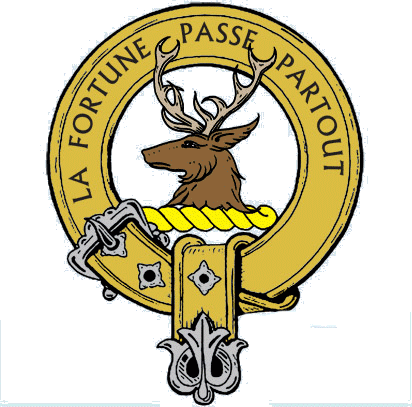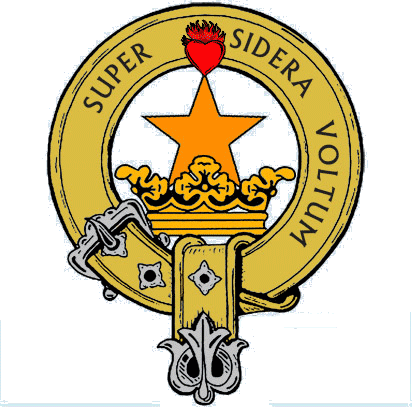A sept is a family or sub-clan which has sprung from or, was allied to for protection by, a parent clan. Septs branche off from the parent clan, often accompanied by a change in name. For instance, many MacDonalds of Glencoe changed their name to MacIan, after the progenitor of their branch, Ian Og (Young Ian) MacDonald. Thus the MacIans are today a sept of Clan Donald. Equally, it may be a matter of smaller Clans or families paying homage to a larger Clan chief, in return for protection. Although the Chiefs of Clan Oliphant were politically and in land owning terms very powerful between 12th and 17th Centuries, due to the Clan’s relatively small size, it was not a great power in itself, as the plentiful Macdonalds or Campbells were. In consequence, the Oliphant Clan is recorded by most sources as having few or no septs.
Rather, the absence of a Clan Chief in the Victorian era meant that Clan Oliphant was erroneously listed as a sept of other Clans with whom it had had political alliances. This includes Skene, although for reasons unknown and, Sutherland, due to ignorance about what defines enseptment. In fact, there was one mutual bond between Lord Oliphant and the Sutherland Chief by which, given the power exercised by Lord Oliphant at that time, Clan Sutherland could just as equally be claimed as a sept of Clan Oliphant.
Clan Oliphant is a distinct clan in its own right, as reconfirmed most recently by Lord Lyon in 2003, with septs of its own. Based on bonds signed to the Oliphant Chief for protection, Clan Oliphant theoretically has numerous septs: Barclay of Strowie, Blair of Balthayock, Bruce of Copillindy/Cultmalundie, Ferny of the Ilk, Fotheringham of Prowie, Gorthy of that Ilk, Kinloch of Kinloch, Mercer of Innerpefry, Moray of Abercairney, Ogilvie of Inchmartin, Rattray of that Ilk, Rollo of Duncrub, Rollok of Fyndone, Stewart of Fothergill and Thane of Dunning *20 However, only one of these: Kinloch, specifically recognizes themselves as such today.
Of the Kinloch connection, the Kinloch Clan (family motto “yet higher”,) is quite small in its own right and linked to the Oliphants of Bachilton, a branch off the 2nd Lord, whose line made a wrongful claim as 12th Lord after returning from the West Indies with money.
With the exception of the Kinlochs, all the above clans (including the chiefs of Clans Ferny, Gorthy, Rattray and Rollo) signed bonds of manrent to the Oliphant Chief *19 (as recorded in the Lord Oliphants’ Charter Chest, now combined with Gask’s at the death of the ninth Lord, when placed there for safekeeping.) All of these Clans lived in a close proximity to each other in Perthshire so were probably seeking protection under the Lords Oliphant. Although only the Kinlochs consider themselves a sept today, all of the other families mentioned above could conceivably consider themselves a sept of Clan Oliphant. Those of Scottish descent with the names Gorthy, Ferny, Rattray and Rollo, along with the few who can trace their ancestry back to the other specific branches of much larger Clans (Ogivlie’s of Inchmartin, Stewart of Fothergill, etc.,) are entitled to wear the Oliphant tartan and to link themselves to Clan Oliphant today.
The two clans who would most protest to being associated as a sept of Clan Oliphant, even with the concession of it being merely a theoretical septdom, are the Rattrays and the Rollo’s, as both today are Clans in their own right. This seems to be because the bond was signed to the 1st Lord Oliphant, and later Lords Oliphant lost most of their land and power, thus weakening their authority. There is also a factor of “accepted practice” that is necessary for a sept to be considered as such, and not only a signed bond of manrent. It seems that soon after these bonds were signed, the respective Chiefs were able to support their clans again and no longer needed the patronage of the Oliphant Lords. It is not known whether the Rollos or the Rattrays were at the time considered a sept, in theory or in practice. It should be noted, that most of these bonds of manrent were signed to the first Lord Oliphant specifically, who’s “importance is best shown by the numerous bonds of manrent granted to him by his neighbours” *18.
Sources
*18) “Scots Peerage” – pp. 541
*19) “Gask Charter Chest”
*20) “MacFarlanes Genealogy of the Oliphants” pp. 109-111









